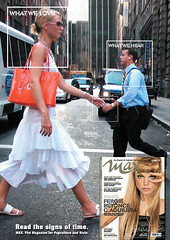
Do You Know This Woman? (Part II)
Originally uploaded by lorenzodom
Do You Know This Woman? (Part II)
Read Part I
I work for a big company, a Fortune 100 company, as a director of marketing and communications. In fact, I’ve worked in advertising and marketing for twenty years now.
Thus, I well know that the standard and most ethical business practice is that you get your photos from either internal sources for art, photos and design or your company purchases images from stock photo companies or independent photographers for both internal and external presentations, storyboards and mock advertisements.
Otherwise, I guess, like DDB, you can just rip them off the Internet….
Which is exactly what happened here. Grand theft auto, information highway robbery, a heist on the autobahn of advertising.
All my images and photos are copyrighted. Yet, they still took a screenshot and lifted one of my photos right off of flickr and used them for business purposes, as mocked up above.
It’s one thing for an individual to blog someone else’s photo with a link directly back to the page or to publicize it in a magazine after you’ve asked permission, but it is really another to manipulate it and then to ask, after the fact.
I suppose I should be grateful that they liked it enough to use commercially, albeit “internally,” and that they subsequently asked me to use it for advertising purposes. Yet, at the same time I feel, somewhat, taken advantage of.
Many photographers get paid lots of money for their photos, yet these guys weren’t willing to pay anything. In fact, last year $822,400 was paid each for Dorothea Lange’s “White Angel Bread Line”and Edward Weston’s platinum print of “The Breast” from 1921. That’s a little less than a million dollars for a single photograph.
And DDB is one of the world’s most successful, richest (i.e. according to Advertising Age’s February 27, 2006 4th Annual Guide to Advertising and Marketing, DDB Worldwide Communications boasts over a billion dollars of worldwide revenue, a 14% increase over last year) and highly visible advertising agency networks, in the world. Thus, they can readily afford to buy stock photos.
Yet, DDB pursued this precarious avenue of taking an image that is not rightfully theirs, manipulating it for their own purposes, and then audaciously sending it to the owner as bait. That’s risky business if you ask me, that’s asking for a lawsuit or some international bad press for possibly illegal and unethical business practices (i.e. intellectual property theft and harassment for looming deadlines).
And albeit their client, Max Magazine, loves flickr photographers and runs a feature on them every month— they’re not willing to pay you for your photos, for your work. They figure that since you’re an amateur (and thus a sucker) they can easily sell you a little “instant fame” in exchange for using your photos for free, so that they can sell more magazines and increase their profit margins at the same time.
Apparently, they’ve already garnered some bad press on this practice.
Here’s more information.
Read Part I




No comments:
Post a Comment